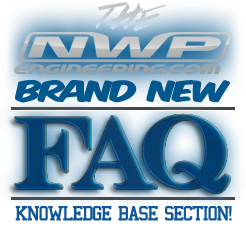FAQ
Technical Performance and Racing Related Questions
What is "low end", "midrange", and "top end" horsepower? And why is it so important to consider when choosing a performance product such as Intake Spacers, Exhaust, Cold Air Intake, etc?
The terms "low end", "midrange", and "top end" are often used when determining the performance of a vehicle. They do not have anything to do with the speed at which the car is moving. But they have to do with how much horsepower the engine makes at a certain RPM. Every engine has, what's called, a "powerband". This is how much power your engine makes at every RPM. Most mildly modified Nissan engines will have a powerband between idle (800rpm) and the stock rev limiter of around 6700 RPM (or 6.7K). "Low end" is a vague term that refers to the lower part of the powerband, which could be between 800 and 3K-3.5K RPM. "Midrange" would be the middle part of the powerband, which could be between 3.5K and 5K RPM. And "topend" would be the highest part of the powerband, which would be between 5K RPM and the rev limiter (6.7K).
Here is our dyno graph comparison sheet for our VQ35DE Maxima Thermal Intake Spacers showing the different parts of the powerband:
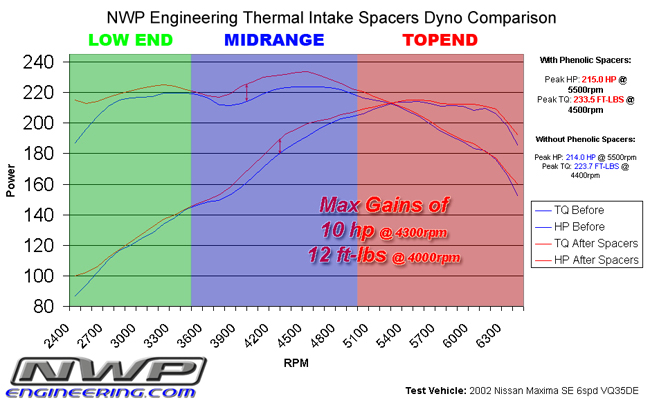
To illustrate, lets say you are racing your Nissan at the drag strip and you are ready to launch your car and go wide open throttle. At the start of the race, your tachometer will read approximately 800rpm at idle. Depending on your launch technique, you will usually start out around 2-3K rpm. That is what is considered the "low end" portion of your powerband. When you launch the car in 1st gear, your tachometer will start at roughly 2K RPM and quickly rise until you have to shift into 2nd gear. You have just gone through your entire powerband just by using 1st gear!
But why is it important to carefully consider this when choosing a particular modification for your engine, whether it is an Intake Spacer Kit, Exhaust, or Cold Air Intake? That is because not all performance parts that are out on the market will make your car accelerate faster. Some actually can make your car accelerate SLOWER than it did before. Some companies claim false and inflated horsepower gains by improper testing or by only posting the peak HP gains and not telling you about the loss in HP found elsewhere in the powerband.
If you actually want your car to accelerate faster in the 1/8 mile, 1/4 mile, or from 0-60mph, you never want to do any modifications that will hurt your midrange or top end power since that is where you spend the majority of your time accelerating.
To understand this, think back to our illustration of the drag strip. You have just raced your car all the way through the powerband in 1st gear. Now you must shift into 2nd gear. Whether you have an automatic or a manual transmission, the results are the same. When you shift into 2nd gear, the tachometer will drop from around 6500 RPM to roughly 4500 RPM depending on your transmission's gearing. You are now in the "midrange" portion of your powerband in 2nd gear. If you keep racing, your revs will rise from 4500 to 6500 RPM and you will need to shift into 3rd gear where the same thing happens again and you are put back into your midrange and top end portion again. The only time your car will see the low part of your power band is during the first few feet of the race. After that, your engine will stay in the midrange and top end portion of your powerband.
So you want to pay close attention to your midrange and top end HP and make sure that when you do a modification to your engine, that it does not decrease the power output in these parts of the powerband. The midrange and topend are VERY CRUCIAL!
It is also fine to increase "low end" power to make your car faster, but be sure that it does not hurt the midrange and topend in exchange for increased low end or you could make your car slower! For instance, you can read more about the effects of using an intake spacer that's too thick by reading the FAQ: Isn't it better to go with an insulating Spacer that's thicker than 1/4"? Bigger is better, right?
And if you do a modification that hurts low end power in exchange for increased midrange and top end power, you MUST gain enough top end to counteract that low end loss or your car will be slower! Our VIAS Block Plate for the 02-08 Maxima is a good example. This modification will hurt low end HP, but since you gain plenty of midrange and top end in exchange, your car will be faster. But this is not the case with the VIAS Block Plates for the 2009+ 7th gen Maxima. Our testing showed VERY large low end power losses without any noticeable increase on top end, which results in a slower car even with the CVT transmission. You can find out more about that by reading the FAQ: Do you sell any VIAS Block Plate Kits for the 09+ Maxima or the 07+ Altima 3.5L?
I see the NWP Engineering 5pc Thermal Intake Spacers make 10hp and 12 ft-lbs of torque on the FWD VQ35DE Maxima/Altima engine. How accurate is that testing?
We conduct the most accurate and extensive testing out of any other company in the market. We do this with all our Intake Spacer Kits. 100s of hours of R&D and testing go into each kit we offer backed up by proven dyno gains. And unlike most other shops, we do not simply advertise 2 dyno charts to show the HP increase. Other shops will choose the lowest HP dyno run before their product is installed and compare it to the highest HP dyno run after their product is installed. This is NOT a proper way to test a product! Every engine is different and most are very inconsistent on the dyno. Dyno results can vary by 5-10HP easily from one run to the next, even when all the variables are taken into consideration, such as the weather and engine temps.
Before we conduct our dyno testing, several measures are taken to ensure consistency. First off, you can only measure accurate HP numbers by locking in one gear ratio for the entire dyno run. This can only be done with a manual transmission or an automatic transmission with the ability to make the entire dyno run without kicking down into a lower gear. This usually requires a standalone transmission control unit such as the Suprastick SSv4. And currently in the Nissan world, you can NOT accurately dyno a CVT (Continuously Variable Transmission) since there is no way to lock in a certain gear ratio. So, since the gear ratios are constantly changing on the CVT, you can not use this vehicle for determining low end, midrange, and top end HP results and comparing before and after dyno runs. So only a vehicle with a manual transmission or a vehicle with an automatic transmission that can lock in one gear ratio can be used.
To further improve consistency and accuracy, we install new spark plugs, the air filter is cleaned, the oil is changed, and the engine is checked for subtle intake leaks that could cause erroneous or inaccurate dyno results. Once we prep the vehicle for testing, several base runs are made to confirm that the engine is producing the most consistent dyno results possible, usually within 1-2whp! And we are not just looking at the peak dyno numbers posted on the dyno sheet. We closely zoom in and analyze the entire power band to make sure we are still within 1-2whp from one run to the next. Once we can get our dyno results within 1-2whp, we know we are ready for testing!
When we advertise HP gains, those numbers are taken from several before and after dyno runs. How do we do that? We average the horsepower and torque gains on 6 or more dyno runs at every 100rpm increment and we make a plot on a new comparison chart. Once all the data is compiled and averaged out, we are able to produce a clean and accurate dyno comparison chart like this:
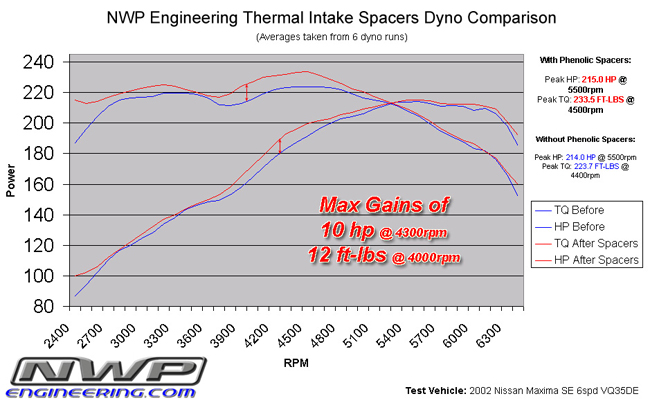
In this particular dyno session, we averaged out 3 dyno runs before the Spacers were installed and 3 dyno runs after. This produces the most accurate dyno comparison possible. So the next time you see advertised HP gains by other companies with other products, know that those numbers are most likely exaggerated since they probably did not take the proper measures to accurately conduct their dyno tests. And as mentioned before, they probably chose the worst dyno run before and the best dyno run after their product was installed to advertise the highest HP gains possible, even though these results would be very inaccurate.
Big Bore Throttle Body Related Questions
Do I need to purchase the entire Big Bore Throttle Body Kit? Will the larger Throttle Body fit by itself?
You will need our Adapter Plate Kit in order to install our 75mm Throttle Body on your engine. Our 75mm Throttle Body is larger than your stock throttle body, which is 70mm. Also, the 75mm TB unit has a different bolt pattern. Also, the electrical connector on the new 75mm TB is different, so you will need our Adapter Wiring Harness as well.
Does your 75mm Big Bore Throttle Body Kit work with aftermarket intake manifolds?
Yes, our 75mm Big Bore Throttle Body Kit works great with aftermarket intake manifolds as long as it has the stock bolt pattern for the stock 70mm throttle body. Our Adapter Plate will bolt up perfectly to it allowing you to install our 75mm Throttle Body Unit along with our Adapter Wiring Harness.
Does your 75mm Throttle Body Kit work with the stock diameter intake tube? What about other intakes such as the Z-tube or a Cold Air Intake?
Yes, our 75mm Big Bore Throttle Body Kit works great with all stock diameter intake tubes. The stock sized coupler will stretch over our 75mm Throttle Body unit. You just may need to warm it up slightly by leaving it direct sunlight to make it more flexible. Also, if you coat the inside of the coupler with a couple drops of motor oil, it will help it slide onto the larger throttle body easier.
Thermal Intake Spacer Related Questions
What are the performance gains if I only some of the Spacers instead of the entire 5pc Kit for the FWD VQ35DE Maxima/Altima Kit?
In all our testing, installing all 5 Spacers of the 5 piece kit is noticeably better than only installing the top 3 Spacers (TB, Elbow, and UIM Spacer).
With all 5 Spacers installed, you will be insulating the lower intake manifold, which gets very hot, 175-185 degrees. (178 degrees to be exact on our 5pc test vehicle) With the addition of the two thin LIM Spacers, the LIM temps were lowered to 144-145 degrees. That is a 33 degree reduction in LIM temps!
As for the UIM, having the entire 5pc kit installed will lower those UIM surface temperatures by 41-43 degrees. The UIM was 146-147 before. And 104-105 after.
Without the LIM Spacers, the UIM temps will be decreased from 157 to 127 degrees for a temperature reduction of 30 degrees. And since the LIM Spacers aren't installed, your LIM will still be blistering hot at 175-185 degrees.
When heat soak is taken into consideration during the testing, having all 5 Spacers really shines as the best. The cooler you keep your intake manifolds, the more power you'll make on those hot summer days when you're hot lapping on the race track or driving in the city from stoplight to stoplight.
What makes your Intake Spacers different than other companies?
Every NWP Engineering Spacer is perfectly matched to the surrounding intake manifolds it mates to. They are never copied from OEM gaskets or another company's product! Various aspects from each of the two mating manifolds are used in order to design a cosmetically pleasing Spacer. Once installed, no part of the Spacer will stick out or appear out of place. It will look just like it was originally designed when Nissan first created the engine. This allows for a very clean look. If the design is based off the OEM gasket or only one of the intake manifold surfaces, the Spacer would not be properly matched to the intake ports and/or the outer contours of the manifolds. Our custom and unique computer aided design usually takes over 100 hours to perfect and come up with a full working set of CAD drawings. Other than coming up with a design for the Spacers, correct fasteners and other hardware have to be determined to allow the entire kit to install flawlessly. Once the entire kit has been designed, a very detailed set of installation instructions with photos is written in order to make the installation procedure go as smoothly as possible.
Here is an illustration that explains what we mean by "various aspects from each of the two mating manifolds are used". This illustration shows what is involved in designing only the Elbow Spacer used in our 02-08 Maxima Spacer Kit. There are two manifolds used to make this unique Spacer design, the Upper Intake Manifold (UIM) and the Elbow manifold. If only one intake manifold was copied, it wouldn't result in the beautiful Elbow Spacer design you see at the bottom of the picture. This unique design technique was also used in our Upper Intake Manifold Spacer and Throttle Body Spacer included in the same kit. If we simply copied only one manifold, our Spacers would not look anything like what they do. We are one of the only companies in the world that spend this much time designing just one intake spacer using this unique method.
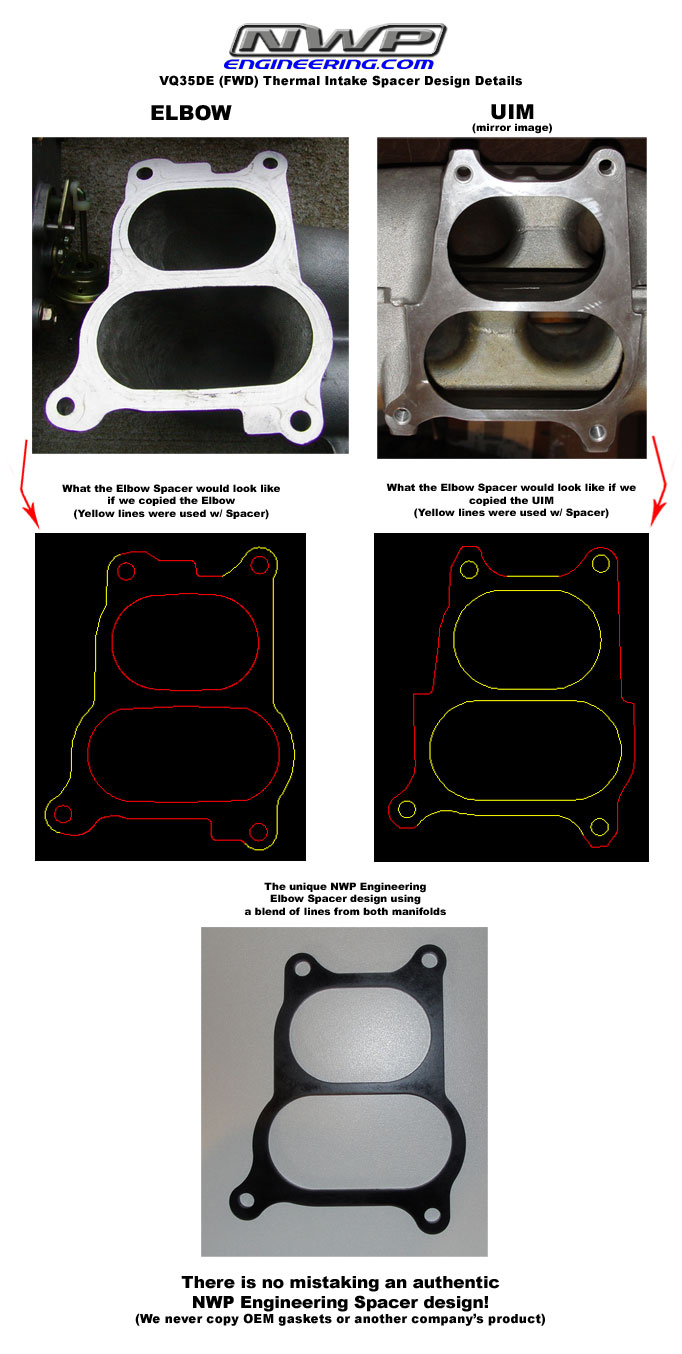
Isn't it better to go with an insulating Spacer that's thicker than 1/4"? Bigger is better, right?
Thicker is not always better. In fact, with the VQ35 02-08 Maxima, if you go too thick, you will shift the power band down lower and will hurt top end HP. And if you actually want your car to accelerate faster in the 1/4 mile or from 0-60mph, you never want to do any modifications that will hurt your midrange or top end power since that is where you spend the majority of your time accelerating.
Whenever you lengthen the intake runners, you will shift the power band down lower, increasing low end power and decreasing top end power. Our 1/4" thick Spacers have been proven in accurate dyno testing to show a 10hp and 12 ft-lbs of torque gain below 5000 rpm. Anything above 5000rpm only shows a 1hp gain, which is virtually unchanged. This tells us that we are right on the verge of losing that crucial top end power. And by simply installing a thicker Spacer or an aluminum 1/4" Spacer, that there would be a loss in top end power. But the reason why our Spacers do not hurt top end power is due to several reasons: 1) They provide a 40-43 degree temperature reduction in intake manifold temperatures. The colder the manifold, the more HP you'll make. 2) Our unique Spacers are perfectly port matched to the larger of the two mating ports. This improves the airflow transition from one manifold to the next. BEWARE! Other spacers on the market are not port matched! 3) By eliminating the non-port matched OEM intake gaskets, you will further improve airflow. If we simply made a copy of the OEM gasket out of 1/4" thick aluminum, the overall power gain would be a lot less and there would be a loss in top end HP because it would not be port matched properly and it would fail to prevent heat transfer like our Thermal Intake Spacers do. But because of our unique spacer design, there is no loss in top end HP. Only gains across the entire power band.
Please keep in mind that not all engines respond the same to Intake Spacers. Some respond best to 1/16" thick Spacers and some respond best to 1" thick Spacers. We have done quite a lot of Spacer testing on the VQ35 over the years, more than any other company! We chose to not exceed a 1/4" thickness with our FWD VQ35 Spacers simply because by going any thicker will hurt your top end power in exchange for improved low end. Low end power may be fun since it will make you think your car is accelerating faster. A low end power gain is much easier to notice in the seat of your pants. But the top end power loss you would experience would counteract that low end power gain which can result in slower 1/4 mile and 0-60mph times.
Also, a thicker Spacer does not mean you'll see better insulation and reduced intake manifold temperatures. In our testing, a 1/4" is more than thick enough to provide the best thermal insulation. In fact, our testing has shown that a 1/16" thick Thermal Intake Spacer insulates just as well as a 1/4" thick Spacer made out of the same material. So going any thicker will not improve the thermal insulation.
At NWP Engineering, we only care about one thing, providing properly tested performance products that will actually make your car accelerate faster and beat the car next to you on the track.
I'm concerned about my front strut tower brace (FSTB) fitment when installing the 5pc Phenolic Spacer Kit on my Maxima or Altima. How much higher will the upper intake manifold (UIM) sit?
Simply put, if you have at least a 1/4" of clearance between your strut bar and your intake manifold, you can install our Spacers without any problems. If you have less than a 1/4" of clearance, you may need to add some washers underneath your strut bar brackets to raise the bar slightly. Or you may choose to grind a little metal away on the intake manifold to increase the clearance. But this is usually not necessary.
On the 02-08 VQ35DE Maxima and 95-99 Maxima, the UIM will be raised exactly 3/16". The upper intake manifold spacer material is made from 1/4" phenolic laminate. The 1/16" thick OEM gasket will be removed, giving you a 3/16" raise in manifold height. On the 92-94 and 00-01 Maxima, the intake manifold is raised 1/4". The OEM UIM gasket on the 92-94 Maxima is made of paper and is very thin. On the 00-01 Maxima, the gasket is thin rubber that sits in a recessed area of the UIM and does not add noticeably to the height of the UIM.
Do your Intake Spacers affect performance in other ways besides lowering temps?
Yes, the Thermal Intake Spacers have many aspects to them as to why HP is increased. The biggest are the reduction in intake manifold temps and better intake air velocity. Since the poorly sized OEM intake gaskets are eliminated, the airflow transition from one manifold to another is improved and turbulence is reduced. Also, since the spacers are a 1/4" thick on the VQ35DE Maxima/Altima Kit, the intake runners are lengthened. In theory, whenever you lengthen the runners, you will increase low end torque, but sacrifice top end power. This is called "shifting the power band". But our spacers do not sacrifice ANY top end power! This is due to the fact that heat soak is considerably reduced by decreasing the intake manifold temps, the perfect Spacer thickness has been chosen (if you go any thicker, you will hurt top end power), the stock intake gaskets are no longer used, and the intake ports on the Spacers are perfectly matched to your intake manifold (unlike our competitors). So what you are left with is a noticeable low end and midrange power gain without sacrificing any top end power resulting in a car that accelerates faster than before.
Will the NWP Engineering VQ35DE Thermal Intake Spacers work with aftermarket or custom intake manifolds?
Yes. Since all NWP Engineering Spacers are perfectly port matched to the stock intake ports, our kit works great with aftermarket upper intake manifolds for the front wheel drive VQ35DE that are currently on the market. The only Spacer that will no longer fit on the FWD 3.5L engine is the Elbow Spacer. Since aftermarket intake manifolds that we've seen so far are all one unit instead of two separate manifolds like the OEM setup, this eliminates the needs for the Elbow Spacer.
I hear a whistling sound after installing the kit for the FWD VQ35DE engine. The car idles and performs perfectly, but is this whistling sound normal?
If your engine idles and runs smoothly, then you most likely do not have any kind of intake leak. With about half of the engines that we tested these spacers on, a whistling sound was noticed. This typically happens at partial throttle around 3000 rpm and depends heavily on what type of air filter setup is used. These spacers were not designed originally with this noise in mind, even though it does sound pretty good in our opinion. We strictly concentrated on improving airflow by port matched spacers and eliminating the poorly sized OEM gaskets, as well as, decreasing temps by over 40 degrees. Most customers who experience this whistling think it sounds great. We have heard this noise and believe it is a great addition to the already aggressive sound you are experiencing if you have an aftermarket air intake setup.
How difficult is the spacer kit to install?
It depends on the vehicle. On the VQ35DE Maxima, the process is relatively straight forward and should only take 2-3 hours and should only require basic hand tools. On the VQ30DE or VQ30DEK Maximas, the process is a little more involved since you have to undo more vacuum lines and breather hoses. Please refer to the instructions set out in the Products section for your particular application. They have been added to the website to help you do a little reading before you order. If you are unsure if you can tackle such a job, it is recommended to have a mechanic friend help out during the install or have a qualified mechanic to do the install entirely. And feel free to contact us anytime if you have any questions.
What does the coolant bypass fitting do that is included in your FWD VQ35DE 5pc Spacer Kit?
The coolant bypass fitting is to bypass the coolant from flowing through the intake manifold. This will prevent hot coolant from heating up your intake manifolds and throttle body once the Spacers are installed. With the use of our Thermal Intake Spacers, bypassing the coolant helps lower the intake manifold temperatures and helps the spacers to do their job, which is to prevent heat transfer.
What is the difference between the 02-03 3.5L Maxima Spacer kits versus the 04-08 3.5L Maxima Spacer kits?
There is no difference. It is the same kit. The 02-03 Maxima does not have an EGR system. But, the 04-06 Maxima does have an EGR system with a tube that connects to the Upper Intake Manifold. This does not effect the Thermal Intake Spacer Kit at all and it is the same design between years 2002 and 2008.
Do you make a Thermal Intake Spacer Kit for the 00-01 Maxima?
We do not make Thermal Intake Spacers specifically for the 2000 and 2001 Maxima. But we do produce a hardware kit that will enable you to install the 95-99 Maxima Thermal Intake Spacers on your 00-01 Maxima. Both Maximas have the VQ30 engine, but the 00-01 has a redesigned variable intake manifold with a different bolt pattern. So to allow the upper intake manifold spacer from the 95-99 Maxima to fit, you will need to make a few minor cuts on the bolt holes. This process will be included in the instructions.
Does the 95-99 Maxima Thermal Intake Spacer Kit work with the MEVI (Middle Eastern Variable Intake) manifold? What about the 00VI (2000 Maxima Variable Intake) manifold?
Yes it does! Very well too! Our Spacers are always port matched to the OEM intake ports and the Thermal Intake Spacers will still offer the same temperature reduction and HP gains as the OEM USIM (United States Intake Manifold). All 4 Spacers can be used with the MEVI without any modification.
And if you ever decide to swap over to the 00VI manifold in the future, you can still use your NWP Engineering 95-99 Maxima Upper and Lower Manifold Spacers! The Throttle Body Spacer can only be used if ported drastically to match the 00VI. But, the two LIM Spacers work perfectly without without any modification. And the UIM Spacer will work too since the intake ports still match up perfectly to the 00VI. A couple of modifications are required to make this happen, though, since the bolt holes do not line up. Please click here to read the Modification Instructions in PDF format.
And since the 00VI manifold is made from a composite resin, the temperature decrease will not be as much as with the cast aluminum USIM, but you will still experience a noticeable intake manifold temperature reduction, as well as, increased throttle response and increased HP throughout the entire power band (low, mid, and top end). It will be a much smoother delivery of power, which is what you want, especially when traction is an issue.
VIAS and EGR Block Plate Related Questions
What does the VIAS Block Plate do?
This is strictly a block plate kit for those that want to remove their VIAS (Variable Induction Air Control System). That will hurt low end power, but since you are removing an obstruction, it will help top end. You will gain approximately 5-8hp on midrange and top end power and your car will accelerate faster from 0-60mph and in the 1/4 mile. The other use for this block plate is known as the SSIM (Secret Sauce Intake Manifold) on the Maxima and Altima discussion forums. That name was created years ago by a member of the Maxima discussion forums. This involves cutting the shelf out of the main chamber of the upper intake manifold and removing the VIAS assembly. This will still lose low end power and some midrange, but the gains in the top end are very noticeable. It's definitely a modification that is worthwhile if you are serious about increasing top end HP. An extended rev limiter is highly recommended if you want to get the full potential out of the SSIM.
What is the difference between the two VIAS Block Plates that are offered?
The Premium kit comes with a block plate that is fully machined out of a solid piece of 6061 billet aluminum with the NWP logo in raised lettering. The plate is fully machined on all sides and the front and back. This block plate with the raised NWP logo has been discontinued and is no longer available.
The Basic VIAS Block Plate Kit comes with a plate that is machined from 6061 billet aluminum and the logo is engraved instead of raised. It is also machined on both sides for a flawless appearance.
Both VIAS Block Plate Kits serve the same purpose.
Here is a comparison:
Raised logo and fully machined on all sides for flawless appearance:
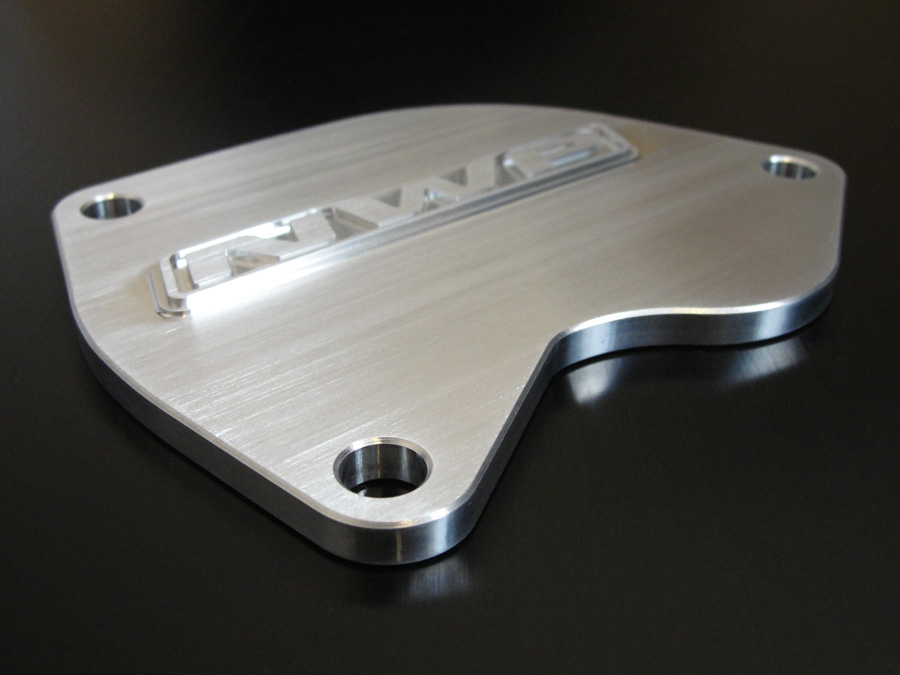
Machined from 1/4" sheet stock with logo engraved:
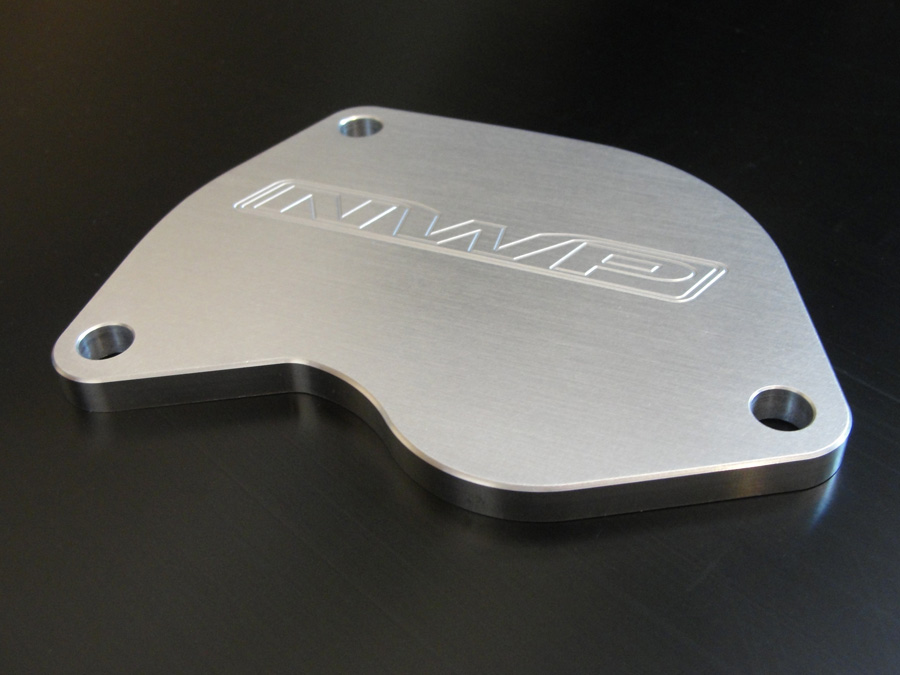
Do you sell any VIAS Block Plate Kits for the 2009+ Maxima or the 2007+ Altima 3.5L?
I'm sorry, we do not currently have any products for the 2009 Maxima. But, we are actively working on some things for this platform that we can't talk about right now.
And we just finished testing our VIAS Block Plate prototypes for this engine, but the HP gains weren't as we expected. The low end power losses were as much as 19 ft-lbs of torque and the top end power gains were as much as 1hp. With these huge power losses, the car would accelerate much slower than before. So, we decided to scrap the entire project so we could concentrate on designing and testing other products for this engine.
You can read more about our 7th gen Maxima VIAS Block Plate testing here on Maxima.org.
Won't I get a Check Engine Light if I eliminate the EGR system on my 04-08 Maxima or 05-06 Altima?
This EGR Block Plate Kit is intended for those that have done an engine swap with the 04-06 Maxima or 05-06 Altima VQ35DE engine and are using a non-EGR ECM such as the 95-99 or 02-03 Maxima ECM. Or you may need this kit if you would like to purchase a used spare 6th gen (04-06) Maxima UIM, but don't need to run an EGR system.
At this time, this kit is not intended to eliminate the EGR system on a street driven 04-06 Maxima or 05-06 Altima, since that will decreases your chances of passing emissions as well as give you a check engine light. So no EGR block plug will be included for the RH exhaust manifold. But we are actively testing this right now on some late model EGR Maximas and Altimas to see if we can reliably eliminate the EGR system on a street driven car without any codes popping up.
What is the purpose of the EGR system and why would I want to eliminate it?
The EGR stands for Exhaust Gas Recirculation. It routes the exhaust gases back into your intake manifold in order for a more thorough burning in order to reduce emissions.
Eliminating the EGR system will prevent those hot and dirty exhaust gases from entering your intake manifold, resulting in more oxygen making it into your combustion chamber for more HP. The HP gains should only be 1-2 hp, if any, but your intake manifold will remain cleaner for longer since carbon buildup from the exhaust gases won’t be an issue.
Ordering, Shipping, Warranty, and Other Questions
What shipping method do you use within the US? What about International?
Almost all of the time, we ship packages via USPS Priority Mail, which only takes 2-3 days to arrive anywhere in the entire US even Alaska, Hawaii, and Puerto Rico. For small items such as our VIAS Block Plate Kit, we use USPS First Class Mail, which usually takes 2-4 days within the US. From time to time, we also use UPS Ground when the transit time is similar to USPS Priority.
We prefer to use USPS within the US due to the speed at which packages arrive to our customers. For instance, if you place an order on our website at 12pm ET on a Friday, it will ship the same day and arrive at your location on Monday. This is because USPS packages continue to move through the weekend. With UPS Ground, they usually don't count Saturday or Sunday as a shipping day. So if we had shipped your Friday order via UPS Ground, it probably wouldn't have arrived until Wednesday for areas that takes 3 days.
We also ship internationally to other countries via USPS Priority Mail International, which usually takes 3 weeks to arrive. We prefer this method since it considerably reduces the amount of duties and taxes our customers have to pay compared to UPS and Fedex. Packages may take longer to arrive with USPS, but the duties are far less resulting in happier customers. If you prefer us to ship via a different method, just email us prior to your order and we will do our best to accomodate you.
Do you accept orders over the phone?
In order to keep costs as low as possible, we do not accept credit cards over the phone. All orders are taken directly through our website. We do offer customer support via email, so feel free to contact us anytime with your questions. Our response time is almost always within 1 business day. If you don't hear back from us within 1 business day, try again. That means we were unable to respond to your email usually due to an incorrect email address specified.
Do you accept Money Orders or Personal Checks?
We do accept Money Orders and Cashiers Checks. Please contact us by email before sending in your order. You will want to mail your payment with a letter enclosed stating the exact product you are ordering to the address below. Be sure you include your full name, shipping address, email address, and contact telephone number.
We also accept Personal Checks, but it could take 2-3 weeks to clear before your product ships.
I have an idea for a new product, will you be able to design and produce it?
If you would like to see us make a new product, please send an email to aaron@nwpengineering.com. If we feel there is enough demand, yes, we will produce your new product and you may be entitled to receive a large discount or even free.
How long has NWP Engineering been in business?
We opened for business in 2007. So you can trust we are going to stick around for years to come!
How does your Lifetime Warranty process work?
We offer a very impressive Lifetime Warranty on all NWP designed products. We are not like other companies. If you have a problem, simply contact us. In almost all cases, we will replace the damaged part free of charge and pay for all associated shipping costs within the US. We even have a Lifetime Warranty on our hardware and gaskets! Yes, even our 75mm Big Bore Throttle Body gasket has a Lifetime Warranty on it which is only designed to be used once or twice before needing to be replaced. Just email us to get your free gasket replacement!
Do you need new NWP decals? Lifetime Warranty on those too!
We have been in business and getting flawless reviews from our customers since we opened in 2007. So you can trust that we will still be here when you need us!
How can I leave a review for NWP Engineering?
We really appreciate your business and support! If you'd like to post a review, you may do so on our Facebook page here: https://www.facebook.com/NWPEngineering/reviews
And if you are a part of any Nissan related Facebook Groups or a discussion forum such as Maxima.org, my350z.com, G35Driver.com, or NissanClub.com, please feel free to post there as well in a new thread. A good "word of mouth" referral from a happy customer is the best way to help us out and help spread the word about NWP. It's customers like you that keep our doors open!



